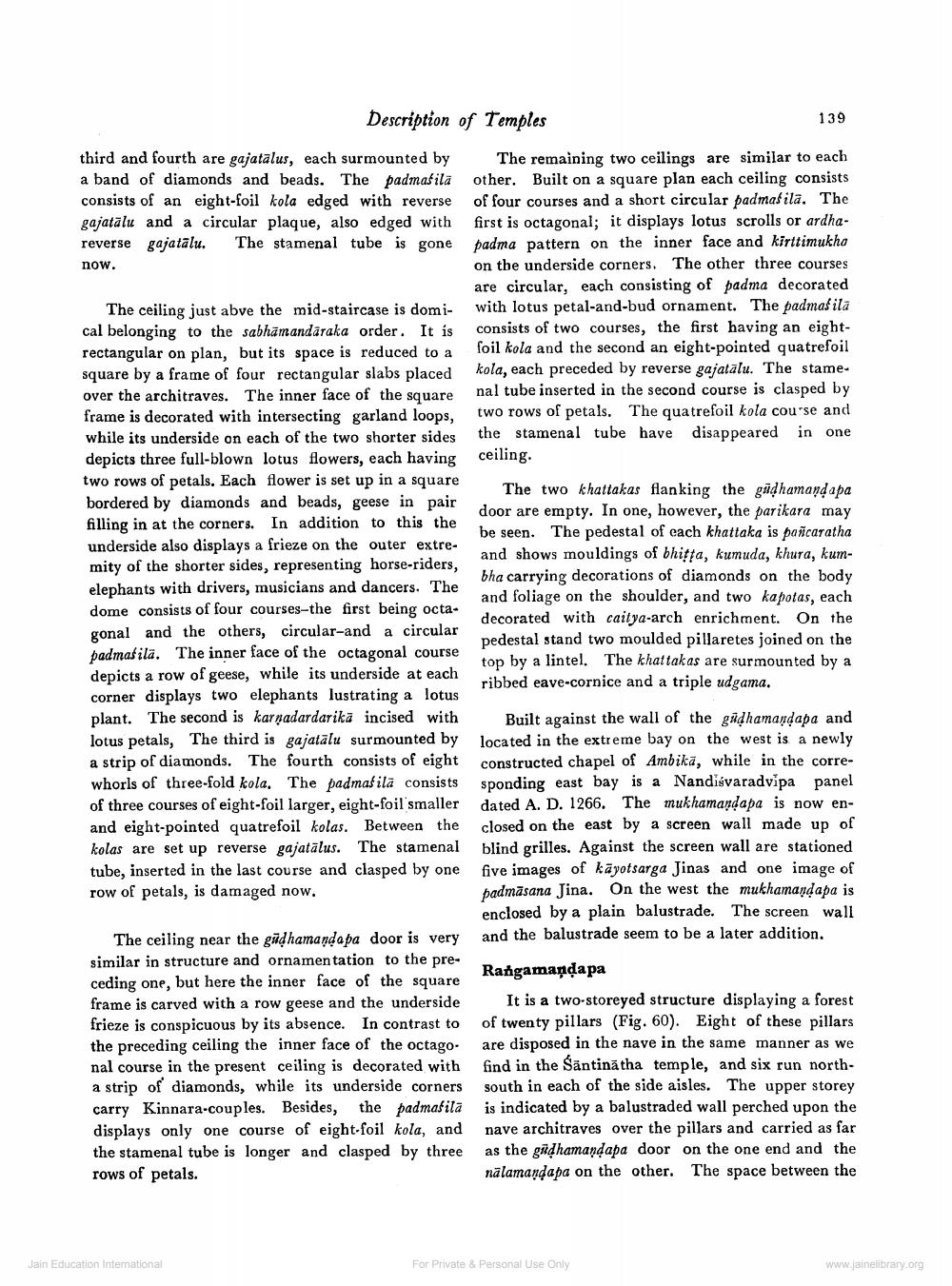________________
Description of Temples
139
third and fourth are gajatālus, each surmounted by a band of diamonds and beads. The padmašila consists of an eight-foil kola edged with reverse gajatālu and a circular plaque, also edged with reverse gajatālu. The stamenal tube is gone now.
The ceiling just abve the mid-staircase is domi- cal belonging to the sabhamandaraka order. It is rectangular on plan, but its space is reduced to a square by a frame of four rectangular slabs placed over the architraves. The inner face of the square frame is decorated with intersecting garland loops, while its underside on each of the two shorter sides depicts three full-blown lotus flowers, each having two rows of petals. Each flower is set up in a square bordered by diamonds and beads, geese in pair filling in at the corners. In addition to this the underside also displays a frieze on the outer extremity of the shorter sides, representing horse-riders, elephants with drivers, musicians and dancers. The dome consists of four courses-the first being octagonal and the others, circular-and a circular padmašila. The inner face of the octagonal course depicts a row of geese, while its underside at each corner displays two elephants lustrating a lotus plant. The second is karņadardarika incised with lotus petals, The third is gajatālu surmounted by a strip of diamonds. The fourth consists of eight whorls of three-fold kola. The padmašila consists of three courses of eight-foil larger, eight-foil smaller and eight-pointed quatrefoil kolas. Between the kolas are set up reverse gajatālus. The stamenal tube, inserted in the last course and clasped by one row of petals, is damaged now.
The remaining two ceilings are similar to each other. Built on a square plan each ceiling consists of four courses and a short circular padmašila. The first is octagonal; it displays lotus scrolls or ardhapadma pattern on the inner face and kirttimukha on the underside corners. The other three courses are circular, each consisting of padma decorated with lotus petal-and-bud ornament. The padmašila consists of two courses, the first having an eightfoil kola and the second an eight-pointed quatrefoil kola, each preceded by reverse gajatālu. The stame. nal tube inserted in the second course is clasped by two rows of petals. The quatrefoil kola course and the stamenal tube have disappeared in one ceiling.
The two khattakas flanking the gâdhamandapa door are empty. In one, however, the parikara may be seen. The pedestal of cach khattaka is pañcaratha and shows mouldings of bhitta, kumuda, khura, kumbha carrying decorations of diamonds on the body and foliage on the shoulder, and two kapotas, each decorated with caitya-arch enrichment. On the pedestal stand two moulded pillaretes joined on the top by a lintel. The khattak as are surmounted by a ribbed eave-cornice and a triple udgama.
Built against the wall of the gådhamandapa and located in the extreme bay on the west is a newly constructed chapel of Ambika, while in the corresponding east bay is a Nandiśvaradvipa panel dated A. D. 1266. The mukhamandapa is now enclosed on the east by a screen wall made up of blind grilles. Against the screen wall are stationed five images of kāyotsarga Jinas and one image of padmāsana Jina. On the west the mukhamandapa is enclosed by a plain balustrade. The screen wall and the balustrade seem to be a later addition.
The ceiling near the gūdhamanda pa door is very similar in structure and ornamentation to the preceding one, but here the inner face of the square frame is carved with a row geese and the underside frieze is conspicuous by its absence. In contrast to the preceding ceiling the inner face of the octago. nal course in the present ceiling is decorated with a strip of diamonds, while its underside corners carry Kinnara-couples. Besides, the padmašila displays only one course of eight-foil kola, and the stamenal tube is longer and clasped by three rows of petals.
Rangamandapa
It is a two-storeyed structure displaying a forest of twenty pillars (Fig. 60). Eight of these pillars are disposed in the nave in the same manner as we find in the Säntinātha temple, and six run northsouth in each of the side aisles. The upper storey is indicated by a balustraded wall perched upon the nave architraves over the pillars and carried as far as the gâdhamandapa door on the one end and the nālamandapa on the other. The space between the
Jain Education International
For Private & Personal Use Only
www.ainelibrary.org




